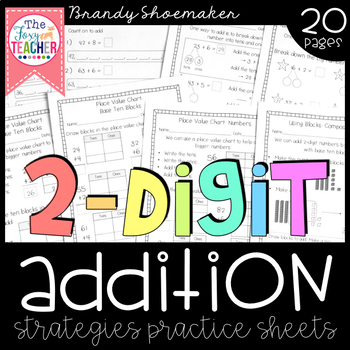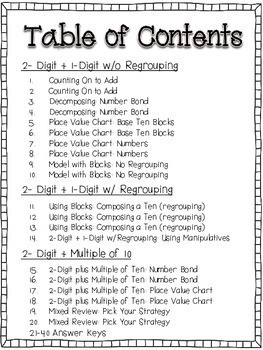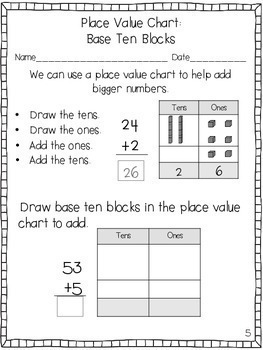Two-Digit Addition Strategies Practice Sheets
- PDF
What educators are saying
Description
Help your students develop and practice different strategies for solving two-digit addition with this mega-pack of practice sheets! The practice sheets (20 pages plus 20 answer keys) are designed to address a portion of the first grade Common Core standard 1.NBT.4 and give you a quick and easy framework for teaching the types of addition problems specifically called for in this standard. Problem types include 2-digit plus 1-digit without regrouping, 2-digit plus 1-digit with regrouping (composing a ten), and 2-digit plus a multiple of ten. Strategies covered include counting on to add, decomposing the 2-digit number using a number bond, using place value charts with base ten blocks and numbers, and using base ten blocks to compose a ten (regroup).
Provide students with manipulatives (base ten blocks) to use alongside the practice sheets to strengthen and enhance student practice.
Pack includes:
2-Digit plus 1-Digit w/o Regrouping Pages:
Counting On to Add
Counting On to Add
Decomposing: Number Bond
Decomposing: Number Bond
Place Value Chart: Base Ten Blocks
Place Value Chart: Base Ten Blocks
Place Value Chart: Numbers
Place Value Chart: Numbers
Model with Blocks: No Regrouping
Model with Blocks: No Regrouping
2-Digit plus 1-Digit w/ Regrouping Pages:
Using Blocks: Composing a Ten (regrouping)
Using Blocks: Composing a Ten (regrouping)
Using Blocks: Composing a Ten (regrouping)
2-Digit + 1-Digit w/Regrouping: Using Manipulatives
2-Digit plus a Multiple of Ten Pages:
2-Digit plus Multiple of Ten: Number Bond
2-Digit plus Multiple of Ten: Number Bond
2-Digit plus Multiple of Ten: Place Value Chart
2-Digit plus Multiple of Ten: Place Value Chart
Mixed Review: Pick Your Strategy
Mixed Review: Pick Your Strategy
21-40 Answer Keys
NOTE, PLEASE READ before downloading: Pack does NOT include 2-digit plus 2-digit problems (ex. 34+25) besides those with a multiple of ten. This is because the standard 1.NBT.4 does not call for this type of problem. I create these math packets with careful attention to the intent of the standards! Second grade standard 2.OA.1 addresses 2-digit plus 2-digit addition within one hundred.
Sheets designed to for first grade but would also be a great review or intervention for second grade students still struggling with 2-digit addition. Also great as an enrichment for Kindergarten!





